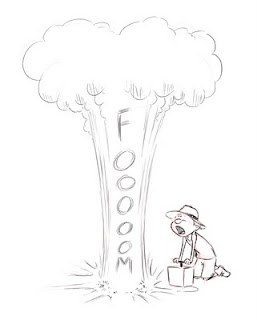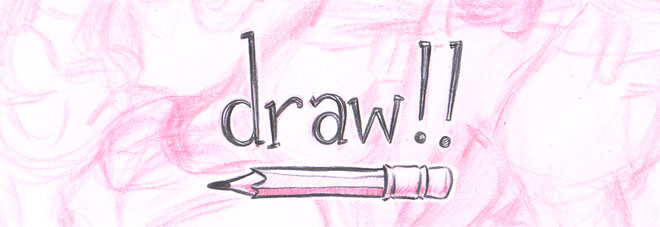
There's been a battle going on in the Melbourne suburb of Brighton for the last three months, one that should have been resolved by now but, to the frustration of those of us involved, still lingers on due to the unwillingness of the company involved to resolve it. Now, I don't usually write up opinion pieces and prefer to post artwork on this blog partly for the fear of putting my foot in my mouth, however I'm going to hold my silence no more.

Well, it all culminated three months ago, when without notice or warning more than half of the staff were told as they were finishing up for the day not to come in the following day, that they were being "stood down"- whatever that was supposed to mean. We weren't being fired, sacked, made redundant or let go, we were still technically regarded as employees of the company but being asked to sit on the sidelines and wait anywhere from approximately 2 to 8 weeks, until the company had sorted out the mess it had gotten itself into, there was a catch though-we just weren't going to be paid. And as it turned out, also for the week and a half preceding this announcement. There'd be weekly updates on the situation they also told us, and what have we received? Sweet bugger all.
But don't just take my word for it; this article hit the local trade press the day after it happened.
Then there was this article from a major Australian paper.
Followed by this again from the trade press.
And ScreenHub have reported on it here, here and here. For those without a subscription, here's a copy of their latest article from last week-
Melbourne Animation Turmoil: battle moves to art
Screen Hub
Monday 11 January, 2010
With the Melbourne animation community buzzing with the matters surrounding Ettamogah, there are many theories about the problem. But nobody will go on record...
The industry knows there is problem. With a maximum of around 120 official staff, very few are actually working. The rest are suspended in limbo, pending promises to return, to bring pay up to date, to deal with the unpaid superannuation.
The other Melbourne animation outfits have been fielding emails for months from Ettamogah staff looking for work.
As of the beginning of December, the company was being advised by "a production consultant". Managing Director Leigh O'Brien was reassuring his staff that entitlements were a priority, and they would be notified about a new structure.
The phrase "production consultant" is code for "completion guarantor."
We know that the MEAA is involved. We know that the Australian Writers' Guild is in there too. We know that a heap of people have discovered good reasons to join a Union.
We also know that Li'l Larrikins is an ambitious 3D animation series, with a presale from Network Ten. The amount is confidential, but the deal has not been put to Screen Australia, where it would be subject to the floor price of $95.000 per half hour.
We understand that Ten has stockpiled enough material that it is not in desperate need of the show to satisfy its content requirements.
Ettamogah has never announced an international presale for Li'l Larrikins. Ettamogah execs hired a booth at MIPCOM and worked hard to create interest in the series.
A hypothetical production of this scale, with around 120 staff, paid a conservative $60k each on average, shooting for twelve months, will cost around $7.2m in wages.
This hypothetical show has a low presale figure of $55,000 in Australia. This hypothetical show will recover its costs solely from international acquisitions.
You can see why the financiers of this show would be concerned. And why such a show might have a cash flow problem.
Any attempts to deal with schedule problems by outsourcing work overseas will ultimately create an income problem - that expenditure is not a qualifying Australian expenditure according to the tax regulations.
Everyone with any internal knowledge of Ettamogah has private theories about the situation. They will inform the thinking of a generation of animators as they build their own projects and companies. Trauma does that to people.
Now, an anonymous cartoonist has arrived on Blogger to publish a series on the workings of a company called Docklands Entertainment.
In the about section, it says
"Sally Quince and Bret Braddock are not real people. They only seem like they might be.
Docklands Entertainment is not a real company. No real company would function like this.
Nobody writes or draws this comic strip. Who would bother?"
You can decide for yourself which company is being parodied.
We will give you one hint - it is neither Channel Seven, which has a studio in Docklands, or the Melbourne Central City Studios, based in Docklands.
Perhaps you too can learn something about the adventure of building a new enterprise. With just a few clicks, you may avoid the suffering that the good folks at Ettamogah are surely enduring.
As Colin South is prepared to say on the record, "It is really sad that this has happened. It is sad that people will always remember the bad stories."
"The guy [Leigh O'Brien] has to take responsibility for what he has done, but there are no books on how to set up a studio, and you have to learn from experience. We made a lot of mistakes at the outset, like everyone else, and at the end of the day, it is the people you want to protect."
"I am really disappointed, particularly in an environment where everyone is looking at co-productions as a solution. A studio which produces internally is helping to create the next generation of designers and board artists and lead animators and production managers. That is the sad part about it, and I do hope they manage to keep going somehow."
This sort of practise was common in the late 80's and early 90's when animation was having a resurgence. Entrepreneurial types would raise a pile of money, hire a bunch of young, enthusiastic artists trying to get a break into the industry, and try and fly a turkey that would no doubt end up crashing and burning. I know, I got burnt a couple of times early in my career. But I would have thought that sort of reckless abandon was by the wayside now. Apparently not. As it currently stands, the company is still delaying requests to outline a resolution regarding its staff to both the Government watchbody and the union refusing to grant access to staff records.
It's caught out people again trying to make a start in the industry (especially post-Disney) and also those with experience, leaving an oversupply of talent in the local animation community and everyone wondering "Is this cruel mistress of animation actually worth all this torment?"

But, how did this happen? Were there warning signs? Yes, I think there were, and many, and as employees, we chose to ignore them because we figured the company was starting up, having teething problems, the paycheque (at that stage) was coming in, we were doing what we loved, name your excuse.

Now I've never run my own animation company or tried to start one up and as Colin South, who I have known for many years says- there's no textbooks on how to set one up, but I have worked in the animation industry for nearly twenty years now on Feature films and TV series and if I owned the license to a comic strip and decided to create an animated TV series based on it here's what I'd do- For starters, I'd look to hire someone who had a sizeable amount of experience in the animation industry, preferably as a director, but at least a key creative person who had a thorough grasp of the process and what was involved in putting it together. Also, I'd hire a writer who'd had some experience in the market I'd be looking at pitching towards (kids TV), preferably as a lead and I'd hire a producer who'd also had experience in animation to create a budget and a schedule and also to lead the sale of the product. And the easy thing about hiring these people, they get credits on everything they work on and there's a one-stop-spot to verify it.
These three key personnel wouldn't be cheap, but they'd be the key staff and decision makers leading the project. They'd be the people that the production staff when hired, would look to for advice, to have made the decisions to move the production on to completion, people the workers would have faith in. I'd get them to collaborate and come up with a product that suited the market, was well crafted and artistically achievable within a set schedule and budget. You see, the budget/schedule, art and writing are all intertwined. Do some research, ask some questions. Figure out how we're gonna do this. It wouldn't have to be ground-breaking, revolutionary, star trekking stuff, simply a product that was appealing, solid and doable.
As a result of this process I'd then have a collection of artwork depicting the characters and setting in a style that was deemed appropriate and achievable given the budget and schedule. As nice as it would be to have Michelangelo's Sistine Chapel painting, expecting it for the budget of a Marvel comic would probably be asking a lot. I'd also have from the writer what is termed "a Bible"- basically a document which says who all the characters are, their personalities, describes the location, gives a run down of the premise of the series and has a breakdown of the individual episodes. This also would be tailored to suit the artistic style of the show and production method. For example, you wouldn't load up a show that's budgeted as a sit-com with expensive action scenes, masses of crowds or loads of locations.
From this I'd then have the basic pre-production assets to launch into production. Some things may need further development or expanding but this is done at this early stage when costs are low as opposed to when it hits production when the majority of staff are hired and things are considerably more expensive. You see, with animation, it's all about the planning.
And with setting up the studio, again I’d seek input from these three key personnel to create a comfortable, efficient and productive environment. I’d find out what equipment was needed; hardware, software, stationery, whether there was any special requirements. Weigh up cost versus productivity on certain items. Then as needed, I’d hire the relevant, qualified and experienced people to set it up for me.
Seems like common sense doesn't it?

You'd think so...




